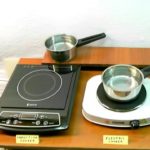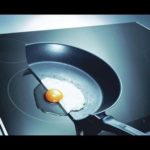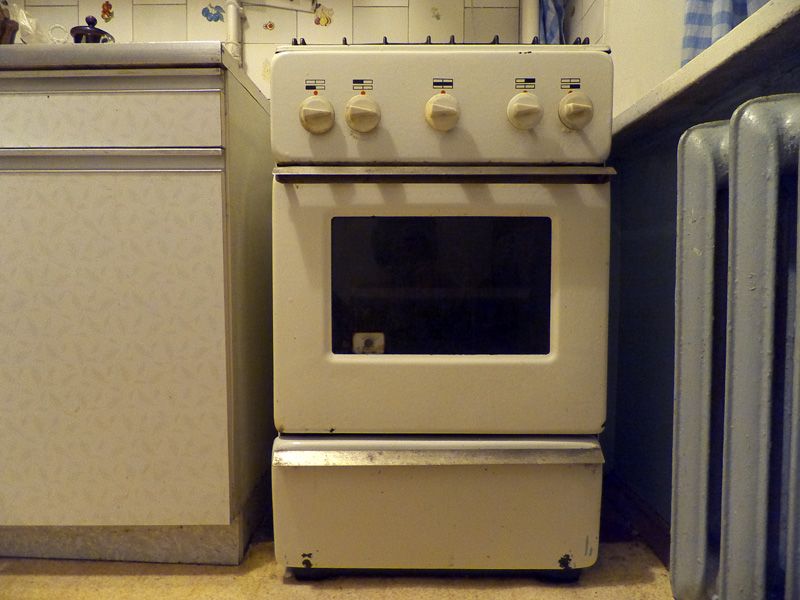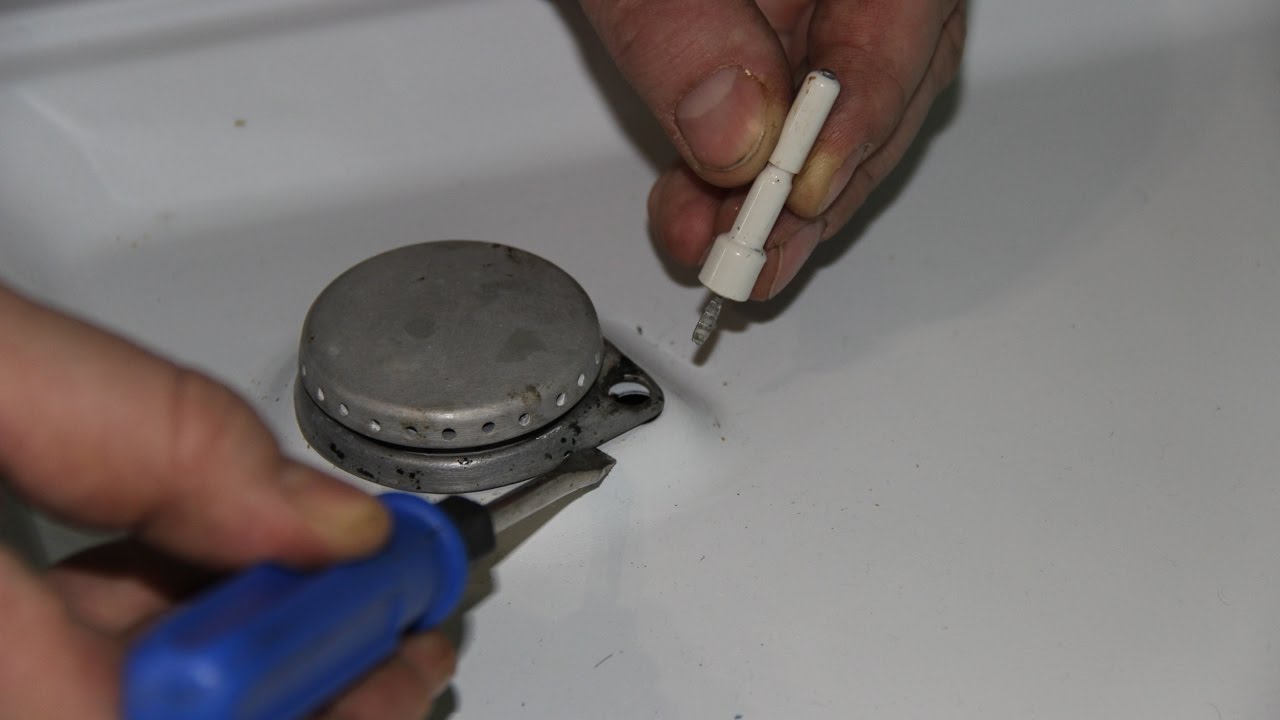Working principle of an induction cooker
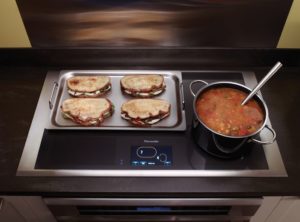 The development of kitchen appliances does not stand still, and recently modern models have appeared among household appliances, which quickly gained popularity. We are talking about induction hobs.
The development of kitchen appliances does not stand still, and recently modern models have appeared among household appliances, which quickly gained popularity. We are talking about induction hobs.
Let's take a closer look at what a device is that operates on the basis of physical phenomena such as induction currents.
The content of the article
Types of induction cookers
This type of panel came to kitchens in the 80s of the last century. At this time, the first commercial samples appeared under the AEG brand. Their cost was very high. In addition, buyers were not ready to give up traditional, well-known and reliable stoves. Therefore, the new surfaces were met with rather indifference.
However, gradually there were more and more admirers of induction units. Such cooking devices are no longer a rarity in the kitchen. Many housewives have their own experience of using them.
Nowadays, trade offers several types of induction panels. 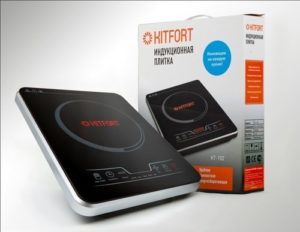
- Complete with oven. This is a cooker consisting of two parts: an induction hob and an oven.
- Combined instruments. These appliances have several different burners. Some devices combine the operating principle. For example, in a panel of four burners, two are induction and two are conventional electric.
- Multi-burner hob. It is convenient because it is easily inserted into the tabletop. At the owner's request, it can be combined with an oven, which is placed directly under the surface. But this is not the only option, because the space under the countertop can be taken up with spacious drawers. They will always have different kitchen utensils at hand.
- There are also small stoves with one burner. They are convenient for their mobility. It is not necessary to look for one single place for them, because such tiles can be easily moved to another place. It is also suitable for transportation; you can even take it with you on a business trip or travel.
Installation of induction cookers
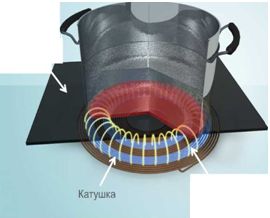
The structure consists of the following elements.
- A horizontal surface, the size of which depends on the number of burners on it. The surface is made of glass ceramics, which is suitable for the functioning of the structure and becomes an interesting interior detail.
- Induction coils that ensure the operation of the device.
- Control block.
Principle of operation

The operation of the device is based on the properties of electromagnetic induction, that is, the appearance of electric current in a closed circuit due to a change in magnetic current.
Reference. This physical phenomenon was discovered by the Englishman M. Faraday back in 1831.
Many electrical appliances that we use every day contain a transformer.
An induction cooker is essentially the same transformer. The operation of the device is simple.The glass-ceramic surface hides the coil that ensures the movement of electric current. Its frequency is from 20 to 60 kHz.
The induction coil is the primary coil; the secondary coil is the saucepan, frying pan or other utensil in which this or that dish is prepared.
When an induction current is applied to the bottom of the cookware, it heats up. Accordingly, its contents also heat up.
Important! The peculiarity of induction cookers is that pots and pans are heated. And the surface itself, located above the heating element and under the dishes, changes its temperature slightly.
Consequently, when heating by induction currents, heat losses are minimized.
Noticeable changes also occur with the time spent heating the dishes. In terms of heating speed, induction designs surpass the results shown by other devices.
Condition for quality functioning
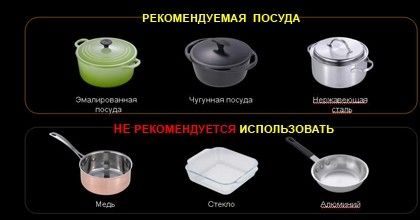
High-quality operation of induction kitchen hobs is ensured by the use of ferromagnetic cookware.
Such pans and pots can be metal. But only a metal that reacts to the action of a magnet will do. Therefore, it is not necessary to look for any specialized dishes. To prepare a delicious dish, it is enough to use ordinary utensils, for example, good old cast iron frying pans. It is even permissible to use enamel cookware, but under one condition, it must attract a magnet.
Important! Dishes made of porcelain, glass and other materials are not suitable for the induction panel.
Requirements for dishes
When using regular cookware, you need to ensure that it meets a number of parameters.
- At the bottom, the minimum diameter should not be less than 120 mm.
- You can use dishes with a bottom thickness of 2 to 6 mm.
- Cookware specially made for use on induction panels has special markings. It is applied to the bottom of the product.
Each manufacturing company labels such dishes according to its own rules. But instructions that it can be used to cook on an induction hob can be found in the instruction manual.
The cost of specially made dishes can exceed the cost of traditional ones and directly depends on the brand. There are many companies involved in the production of special cookware.
Among the leaders are the brands Fissler and Woll from Germany. Their catalogs include more than just frying pans and saucepans. Dutch ovens and other utensils are also popular. Some products are handmade and have a 10mm thick ceramic coated body.
Germany is not the only country specializing in the production of such products. They are also produced by other European countries - Finland, France and many others. The products manufactured here cost slightly less, but are also of decent quality.
Comparison of induction cookers and other cooking devices
Induction units are high-tech devices that use different physical principles than other devices. Induction current opens up new horizons for consumers in cooking and allows complete control over this process.
Differences
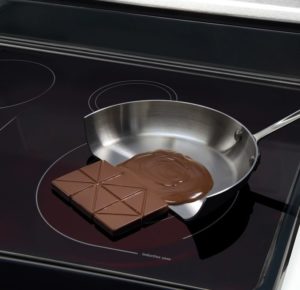
It's all about the principle
The main difference between different cooking devices relates to the principle of their operation.
We won’t dwell on gas units for long. Here the differences are obvious: they are in different types of fuel, thanks to which the device operates.
Electric stoves in this regard would seem to have similarities rather than differences.After all, in these designs everything is based on electricity. But there is still a difference!
When turned on, the electric stove heats up to the set heating temperature. The hot surface of the device then transfers heat to the container and thereby heats the container and its contents.
An induction cooker activates magnetic currents that cause pots or pans to heat up, but the panel does not change its temperature.
Efficiency
Let's compare the effectiveness of using different devices.
Heating efficiency:
- electric stove with glass ceramics - 50–60%;
- gas stove - 60–65%;
- induction hob - 90%.
Pros and cons of induction devices
Advantages
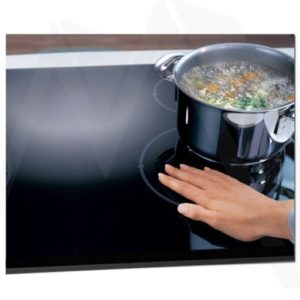
The undoubted advantages of induction devices include the following.
- Increasing the heating rate. When turned on, the dishes and, accordingly, the food are heated, while the panel itself practically does not heat up.
- Saving electrical energy. The physical principles that form the basis of this kitchen appliance allow you to prepare food with minimal energy consumption. This is because energy is expended to create a magnetic field. There is no need to heat up the coil.
- Increased safety of induction kitchen appliances. It is impossible to get burned on its surface. The operation of such a device eliminates the risk of fire, even when the burner is left on for a long time. Once the dish is cooked and the stove is turned off, it will not be hot, but warm.
- Auto power off. The stove independently recognizes the presence of dishes on its surface and turns off automatically.
Flaws
To be fair, it should be noted that such a panel is not without its drawbacks.
- For some consumers, a wary attitude towards a new type of kitchen equipment is due to the fact that cooking on an induction stove requires the use of special cookware. It must have certain ferromagnetic properties. And utensils made of aluminum or glass should not be used.
- It is strongly not recommended to install equipment of this class next to household appliances made of metal.
- The panel of these devices requires careful handling. A lid or knife falling on it may cause a crack. You should also be careful when placing dishes on the stove, because otherwise the stove may break.
- But the key disadvantage of this household appliance is its high cost in comparison with stoves operating on other principles.
Which induction hob to choose?

There is not a large selection of such slabs on the market in our country.
But still, among what is available, you can focus on the models supplied by the AEG-Electrolux concern. In appearance, the products of this company are not much different from a traditional electric stove with a glass-ceramic surface.
As of autumn 2018, its cost is within 30 thousand rubles. is a fully functional kitchen appliance. The burners of this model heat up to 100 degrees in the center, and up to 40 degrees at the edges.
There are no other companies in our market.

